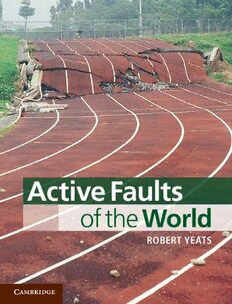Table Of ContentActive Faults of the World
There is an ever-increasing need for a better understanding of regional seismic hazards,
particularlyindevelopingpartsoftheworldwheremajorbuildingprojectsareplannedand
thereisahugemigrationofpeopletolargecitiesthatareatriskfromearthquakes.Disasters
inrecenttimes,suchastheearthquakesinJapanandHaiti,arechillingproofofthedangers
ofbuildinginactivefaultzones.
Thisbookprovidesthefirstworldwidesurveyofactiveearthquakefaults,withafocuson
those described as “seismic time bombs”, with the potential to destroy large cities in the
developingworldsuchasPort-au-Prince,Kabul,Tehran,andCaracas.Leadinginternational
earthquake expert, Robert Yeats, explores both the regional and plate-tectonic context of
activefaultsaroundtheworld,providingthebackgroundforseismichazardevaluationin
planninglarge-scale projects suchasnuclearpowerplantsorhydroelectric dams.He also
highlights work done in more advanced seismogenic countries such as Japan, the United
States,Italy,NewZealand,andChinaashelpfulexamplesfordevelopingnations,providing
animportantbasisforupgradingbuildingstandardsandotherlaws.
Inadditiontoprovidingavaluabletechnicalsummaryofactivefaultzonesworldwide,
the book presents the human side of earthquake science, exploring the impact of major
quakes on social development through history, such as the effect of the 1755 Lisbon
earthquakeontheAge ofEnlightenment. Itwill formanaccessible reference foranalysts
andconsultingfirms,andaconvenientoverviewforacademicsandstudentsofgeoscience,
geotechnicalengineeringandcivilengineering,andland-useplanning.
RobertYeatsisaFellowoftheAmericanAssociationfortheAdvancementofScienceandthe
Geological Society of America. He is senior consultant and partner in Earth Consultants
International, an international firm focusing on earthquake hazards, and also an Emeritus
professor at Oregon State University. He has decades of experience in earthquake geology
worldwide,includingactingaschairoftheInternationalLithosphereProjectonactivefaultsfor
severalyears,andauthoringthreepreviousbooks:TheGeologyofEarthquakes(withKerry
Sieh and Clarence R. Allen), Living with Earthquakes in California, and Living with
EarthquakesinthePacificNorthwest.AnendowedprofessorshipatOregonStateUniversity
hasbeennamedinhishonor,andtheAAPGhaverecognizedhisworkbyawardinghimthe
MichelT.HalboutyHumanNeedsAward.
Praiseforthisbook:
“This book is an astonishing achievement. It is extraordinarily comprehensive and well
illustratedwithseismologicalandgeodeticdata.Itisanup-to-datestartingpointforanyone
who wants a quick introduction to the earthquake faulting of a specific region, and will
remainareliableintroductiontothecontextofadvancesinthefield,andhowtousethem.”
JamesJackson,DepartmentofEarthSciences,CambridgeUniversity
“Thisambitiouscompilationofallthatisknownofthesurfacefaultsofourplanetwillbea
referenceworkformanyyearstocome.Thetextisaudaciousinscope,withmyriadmaps
andtheirassociatedgeodeticvelocityfields.Yeatsencapsulatesdiscussionandcontrover-
sies surrounding faults, providing a guide to the next generation offuture geologists, and
presentshissummariesoffaultzoneswitheasyauthority.”
RogerBilham,DepartmentofGeologicalSciences,UniversityofColoradoatBoulder
“This clearly written and highly illustrated book is the first to augment seismic hazards
assessmentswithdataonthepreciselocationsofactivefaults,theirslip-ratesandearthquake
recurrence intervals, and the elapsed time since the last earthquake on that fault. It is
essential reading for anyone tasked with protecting at-risk populations or infrastructure
pronetoearthquakes”.
GeraldRoberts,DepartmentofEarthandPlanetarySciences,Birbeck,
UniversityofLondon
“RobertYeatshascompiledtheresultsofseveraldecadesofinternationaleffort,producinga
comprehensive geographical coverage, which remains accessible by providing context
throughout.Itisanimpressiveachievementandwillbeanessentialreferencenotonlyfor
academicsandstudents,butalsoforpractitionersinengineeringgeology,civilengineering,
andplanning.”
KenMcCaffrey,DepartmentofEarthSciences,DurhamUniversity
Active Faults of the World
ROBERT YEATS
OregonStateUniversity
cambridge university press
Cambridge,NewYork,Melbourne,Madrid,CapeTown,
Singapore,SãoPaulo,Delhi,MexicoCity
CambridgeUniversityPress
TheEdinburghBuilding,CambridgeCB28RU,UK
PublishedintheUnitedStatesofAmericabyCambridgeUniversityPress,NewYork
www.cambridge.org
Informationonthistitle:www.cambridge.org/9780521190855
©RobertYeats2012
Thispublicationisincopyright.Subjecttostatutoryexception
andtotheprovisionsofrelevantcollectivelicensingagreements,
noreproductionofanypartmaytakeplacewithoutthewritten
permissionofCambridgeUniversityPress.
Firstpublished2012
PrintedintheUnitedKingdomattheUniversityPress,Cambridge
AcataloguerecordforthispublicationisavailablefromtheBritishLibrary
ISBN978-0-521-19085-5Hardback
Additionalresourcesforthispublicationatwww.cambridge.org/yeats
CambridgeUniversityPresshasnoresponsibilityforthepersistenceor
accuracyofURLsforexternalorthird-partyinternetwebsitesreferredto
inthispublication,anddoesnotguaranteethatanycontentonsuch
websitesis,orwillremain,accurateorappropriate.
Contents
Preface:Introductionandhistoricalperspective pagevii
1 Methodsandbackground 1
2 Alaska,Canada,Cascadia,andEasternNorthAmerica 19
3 SanAndreassystemandBasinandRange 79
4 CaribbeanPlateandMiddleAmericasubductionzone 146
5 SouthAmerica 190
6 Africa,Arabia,andWesternEurope 225
7 EasternMediterranean,theCaucasus,andtheMiddleEast 263
8 India,theHimalaya,MainlandChina,andCentralAsia 329
9 JapanandtheWesternPacific 395
10 SoutheastAsia,Australia,NewZealand,andPacificIslands 448
References 501
Index 600
v
Preface: Introduction and historical perspective
Theconstructionofnuclearpowerplants,largedams,andothercriticalfacilitiesintheUnited
StatesandEuropeduringthe1970sledtoarequirementthatthesitesforthesestructuresbe
evaluatedforseismichazards.Anecessarynewapproachtotheevaluationofseismichazards
includedthestudyofactivefaults,whichledtotherecognitioninfaultzonesofearthquakes
thatpre-datedawrittenhistoricalrecord.Paleoseismology,thestudyofancientearthquakes
basedontheirgeologicalexpression,becameaprimarytoolinthesitingandevaluationof
criticalfacilities.However,virtuallyallofthesestudiesweresite-specific,withoutabroader
understandingofthesignificanceofactive-faultfeaturesinthestudyofearthquakes.There
seemed to be a barrier between the study of faults by the structural field geologist and the
analysis of faulting in real time, which includes geomorphic expression of surface rupture
accompanyingearthquakes,andthestudyofhowfaultingispartofthenaturalevolutionof
landscapes,despiteearlyattemptstodothisbyCharlesLyell(1875).
Analysis of active faults built on the work of nineteenth-century pioneers, including
CharlesLyellofEngland(aspartofhisPrinciplesofGeology),G.K.GilbertoftheUnited
States (Owens Valley and San Andreas faults, California, and Wasatch fault, Utah),
AlexanderMcKayofNewZealand(Hopefault),JoséAguileraofMéxico(faultingaccom-
panyingthe1887Sonoranearthquake),andBunjiroKotoofJapan(faultingaccompanying
the1891Mino-Owariearthquake).
AworldwideanalysisofthetectonicsettingofactivefaultsandtheirQuaternaryhistory
didnotbeginuntilafterWorldWarII,whenRobertE.WallaceoftheUSGeologicalSurvey
(USGS)establishedhisscientificreputationwithacarefuldescriptionofactivefeaturesof
theSanAndreasfault(Wallace,1949)andthesurfaceruptureofthe1915PleasantValley,
Nevada,earthquake(Wallace,1984).BobWallacerecognizedthatathoroughunderstand-
ing of active-fault features around the world required an international effort to look for
common properties and to take advantage of a larger worldwide data set of historical
earthquakesurfaceruptures.Wallace’sfirstcompilation,inlargepartlimitedtotheUnited
States, was sponsored by the Geophysics Study Committee of the National Academy of
Sciencesandpublishedin1986asActiveTectonics:StudiesinGeophysics.Thiswasmore
than an academic exercise. In his “anonymous” overview paper at the beginning of that
volume, Wallace pointed out the importance to society of studies of active faults as
indicators of earthquake hazards, and he indicated the importance of current geological
researchasaguidetopolicymakersindecisionsonsocietalproblemsrelatedtoearthquakes.
Bythetimethatvolumeappeared,WallacewasalreadycomparingAmericanactivefaults
with surface ruptures from earthquakes overseas. These included the 1966 Varto, Turkey,
earthquake(M6.8)ontheNorthAnatolianfault,withimplicationsfortheSanAndreasfault
(Wallace,1968),andthe1739Pinglu,China,earthquake(M8)ontheHelanshanfaultinthe
vii
viii Preface:Introductionandhistoricalperspective
Yinchuan Graben, a fault that offset the Great Wall of China (Zhang et al., 1986). This
earthquakeprovidedlessonsforanunderstandingoffaultingintheCentralNevadaSeismic
Zone,includingthe1915PleasantValleyand1954DixieValleyandFairviewPeaksurface
ruptures.
In 1983, inspired by Wallace and his Chinese colleagues in their study of the 1739
earthquake, an international project, A Worldwide Comparison of the Characteristics of
Major Active Faults, was begun as Project 206 of the International Geological Correlation
Programme(IGCP)throughUNESCO.TheleadersofthisprojectwereRobertC.Bucknam
oftheUSGSandDingGuoyuandZhangYumingoftheStateSeismologicalBureauofChina,
although Bob Wallace was clearly the éminence grise for this project. In that same year,
Wallace,togetherwithBillBull,ageomorphologistattheUniversityofArizona,organizedan
international meeting at Winnemucca, Nevada, followed by a field trip through the 1915
PleasantValleyand 1954DixieValley surfacerupturesthatpermitted his Chinesecollabo-
ratorsinthePingluearthquakestudytocomparethe Chinese normalfaultwiththe normal
faultrupturesofcentralNevada.ThefirstmeetingoftheIGCPprojectwasheldinJune,1984,
atKobe,Japan,attheendofaprojectIundertookwithKelvinBerrymanoftheNewZealand
GeologicalSurvey(latertheInstituteofGeologicalandNuclearSciences,orGNSScience),
comparingreversefaultsaffectingthedesignofproposedhydroelectricdamsinCentralOtago
withthoseintheCaliforniaTransverseRanges.
TheobjectiveoftheIGCPproject,discussedatKobe,was“tosynthesizecurrentknowl-
edgeofthecharacteristicsandtectonichistoriesofselectedmajoractivefaults.”Members
of the project were to compile their findings in an atlas “illustrating the seismological,
geological, and geomorphic attributes of the selected faults in a variety of continental
tectonic settings.” The scientists who assembled at Kobe from around the world became
colleaguesandfastfriendsinthiseffort,andcollaborationcontinuestoday,augmentedby
younger workers and scientists from other countries. We were taken on a field trip to the
RokkoMountainsbyProfessorKazuoHuzita,whowarnedthatfaultsintheKobeareawere
very likely to produce a major earthquake in the near future. Professor Huzita’s warning
wentunheededbytheJapanesegovernment.Lessthan11yearslater,the17January1995,
Kobe earthquake of M 6.9 struck this fault system, taking the lives of several thousand
peopleanddestroyingProfessorHuzita’slovelyclassicalJapanesehomenearKobe.
Althoughpublicationswouldbetheofficialproductsofourcollaboration,wedecidedto
meetatdifferentplacestoseevariousfaultsforourselvesandnotberequiredtolearnabout
themonlythroughthelensesofscientificpublicationsfromdifferentcountriesandcultures.
WemetinBeijing,China,in1985andtookafieldtripalongtheTan-LufaultofeasternChina
(LiandZheng,1985).Ameetingin1987,atFranzJosef,NewZealand,wasaccompaniedby
adetailedlookatNewZealand’splate-boundaryAlpinefault(Beanland,1987).In1989,the
yearoftheInternationalGeologicalCongressinWashington,DC,wemetatMammothLakes
intheeasternSierraNevadaofCaliforniaandexaminedtheSanAndreasfaultandnormal
faultsintheGreatBasin,includingtheWasatchfault,firstreportedonbyGilbertin1883.Our
collaborationwasrealizedintwospecialvolumes:Hancocketal.(1991)intheJournalof
StructuralGeologyandBucknamandHancock(1992)inAnnalesTectonicae.TheChinese,
Japanese,andNewZealandatlaseswerecompiled(forexample,ResearchGroupforActive
FaultsofJapan,1991),andWallacecontributedhisSanAndreasfaultatlasintheformofa
ix Preface:Introductionandhistoricalperspective
USGS professional paper (Wallace, 1990). Other atlases were either not published or
appearedindifferentformats,suchasfaultcompilationsforprobabilisticearthquakehazard
analysis.ThetwovolumesthatcompletedtheprojectdescribedfaultsinChina,Greece,India,
Japan, Nepal, New Zealand, Pakistan, the Soviet Union, Turkey, the United States, and
Venezuela.
In1987,RayPrice,thenthepresidentoftheInter-UnionCommissionontheLithosphere,
invitedmetoleadWorkingGroup1oftheInternationalLithosphereProgram(ILP),Recent
PlateMovementsandDeformation,takingtheplaceofitsrecentlydeceaseddistinguished
chairman, K. Nakamura. I invited several of my colleagues from IGCP Project 206 to
becomemembersbecausewewereconvincedthatwehadleftalotofworkundoneinour
studyofactivefaults:notenoughknowntoachieveasynthesis,toofewcountriesinvolved,
and too few scientists from underdeveloped seismogenic nations studying faults that
endangeredtheirsocieties.Ouropportunitycamein1990,whenILPrestructureditsstudy
committeesfromWorkingGroupstofocusedTaskGroups.
Theyear1990wasthebeginningoftheInternationalDecadeofNaturalDisasterReduction
(IDNDR), which was fully embraced by ILP by establishing its Global Seismic Hazards
AssessmentProject(GSHAP),whichbecameTaskGroupII-1.TaskGroupII-2,headedby
Vladimir Trifonov of the Soviet (later Russian) Academy of Sciences, was charged with
makingaworldwidecompilationofactivefaults.Trifonovorganizedafieldexcursioninthe
summerof1990tomajoractivefaultsintheSovietUnion,includingthesurfaceruptureof
theArmenianearthquakeof1988andotheractivefaultsinSovietCentralAsia,includingthe
Talas–Ferganafault.Mywifebecameseriouslyill,andIhadtocancel,soTrifonovsimply
deferredthetripuntilthefollowingsummer.Butinternationaleventsintervened:theSoviet
Unioncollapsedandwasrestructuredintoseparaterepublics,sothatallofthefieldtripstops
TrifonovhadplannedfortheTaskGroupwerenowinforeigncountries!
The chaotic conditions in Moscow caused the leadership of ILP to seek help from the
USGS, and at the American Geophysical Union meeting in San Francisco in December,
1991,TaskGroupII-2wasdividedintoanEasternHemispheregroupheadedbyTrifonov
andaWesternHemispheregroupheadedbyMichaelMachetteoftheUSGS.Astatusreport
on the reorganization and its implications for GSHAP was published by Trifonov and
Machette(1993).
The Western Hemisphere portion of Task Group II-2, which had as its objective the
characterizationofearthquakesourcefaults,beganin1994withacompilationofanational
database documenting seismogenic Quaternary faults and folds in the United States. The
first version of the database was completed in 2004 and contained about 10 000 pages of
documentationon more than 2000 faults inthe United States (http://earthquake.usgs.gov/
regional/qfaults/). This compilation supports the National Probabilistic Seismic Hazard
mapsandisrevisedevery5yearstoupdatetheprobabilisticstrong-groundmotionhazard
used in the International Building Code. The second version of the maps using the fault
databasewaspublishedbyPetersenetal.(2008).
The American database became the model for compiling fault maps for the Western
Hemisphere,focusingonLatinAmerica.ILPprojectmeetingswereconductedinMérida,
Venezuela,inJanuary,1992,Quito,EcuadorandGuatemalaCity,GuatemalainFebruary,
1993, and Caracas, Venezuela, in March, 1997, as well as meetings at the International

